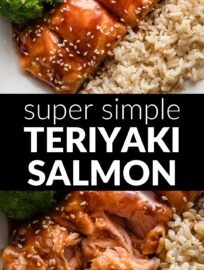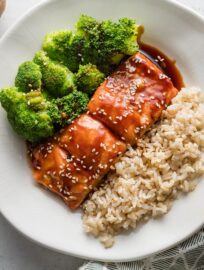Teriyaki Salmon
This post may contain affiliate links. Please read our disclosure policy.
Teriyaki Salmon is one of my favorite ways to simplify a healthy and high-protein dinner, with a truly irresistible sauce, quick and hands-off method, and short ingredient list. Serve with rice, steamed veggies, or both for a fool-proof yet super satisfying meal.
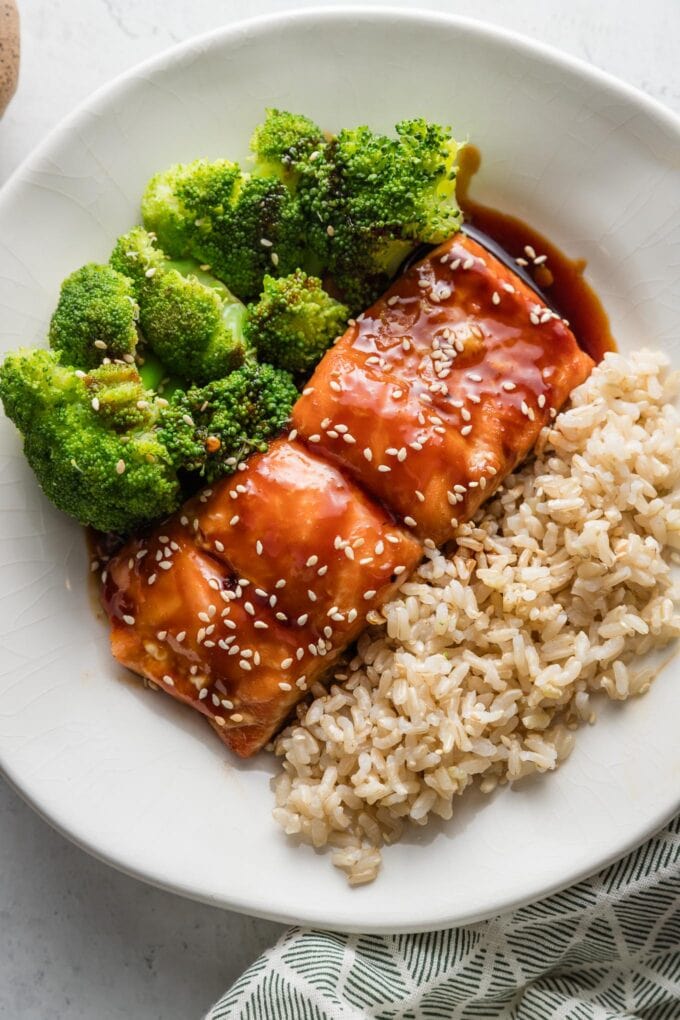
Sweet, sticky, and irresistible salmon.
I am not exaggerating to say I could make this salmon every week forever: it’s easy to whip up without major effort, delivers lots of satisfying protein and heart-healthy omega-3s, and most importantly, tastes absolutely amazing. The sweet, salty teriyaki sauce is so simple to make from scratch, perfectly coats the salmon for rich flavor, and does double duty as a marinade and drizzling sauce. Even my newly four-year-old daughter hoovers up this salmon, and that is pretty darn cool.
We love teriyaki salmon for the base of a dinner and typically pair it with steamed rice and broccoli, though roasted broccolini, steamed edamame, or a light salad would also go really well. You can also make a large batch and enjoy in bowls or mixed into salads for lunches throughout the week. Every time I have made this, I have wished I’d made more. Shop accordingly! 🙂
Ingredient Notes & Substitutions
Any time I can make a sauce from scratch without a super long list of ingredients, it feels like a big win. Here is what you will need:
- Soy sauce. A low-sodium variety is nearly always preferred.
- Rice vinegar. Apple cider vinegar or white wine vinegar — not to be confused with standard white vinegar — are good substitutes.
- Toasted sesame oil. Useful in so many great sauces, including our family favorite Korean ground beef bowls.
- Brown sugar and honey. A little of each adds sweetness, of course, but also a subtle layer of flavor.
- Dried spices and aromatics. Ground ginger, garlic powder, and an optional pinch of red pepper flakes. You’ll also want a small amount of cornstarch to make into a slurry that will thicken the sauce.
- Salmon! Obviously. Because you will be marinating the fish, I find this recipe most effective to make with pre-cut salmon fillets rather than with a large side.

Find the full printable recipe with measurements below.
How To Make Teriyaki Salmon
Easy does it, as it does in pretty much all my favorite practical weeknight meals.
Simmer the Sauce: Combine all sauce ingredients in a small saucepan or skillet set over medium-high heat. While it starts to bubble, dissolve 1 teaspoon cornstarch into cool water to make a thin slurry. Stir the slurry into the simmering sauce, then continue cooking for a few minutes more, until it is thick enough to visibly coat the back of a spoon. This is your sauce! Set it aside to cool for 5-10 minutes.
Pro Tip
Always incorporate cornstarch as a slurry — dissolved into cool water first — rather than adding the powder directly to a hot sauce. The slurry will thicken things up quickly but smoothly. In contrast, cornstarch powder mixed straight into a hot sauce will seize up into small clumps, which are very difficult if not impossible to whisk out.
Marinate the Salmon: After the sauce has cooled very slightly, pour about half of it over the salmon fillets. Press down the salmon and spoon sauce over top to be sure it’s reasonably well-coated. Marinate for 15-20 minutes at room temperature or up to 24 hours refrigerated.
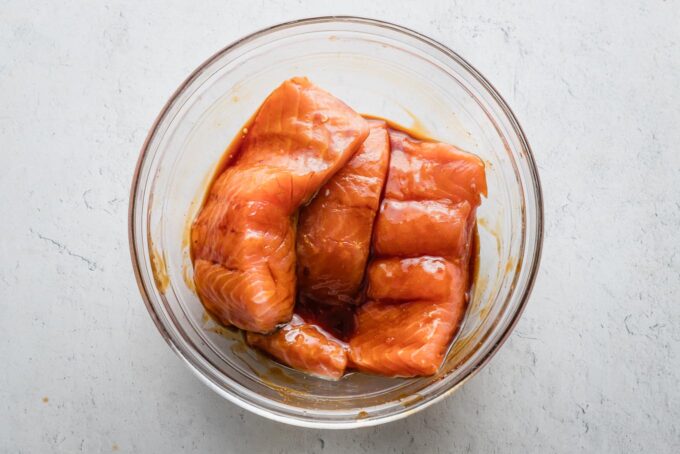
Roast: When ready to bake, warm the oven to 400 degrees F and line a rimmed baking sheet with parchment paper to guarantee easy clean-up. Roast salmon for about 15 minutes, until it reaches 140 degrees F in the thickest part and flakes very easily with a fork. The exact cooking time will depend on the thickness of your fillets and your exact oven temperature.
Serve: Plate the fully cooked salmon with any sides as desired, and drizzle the reserved teriyaki sauce generously on top. Sprinkle with toasted sesame seeds for a lovely little garnish.
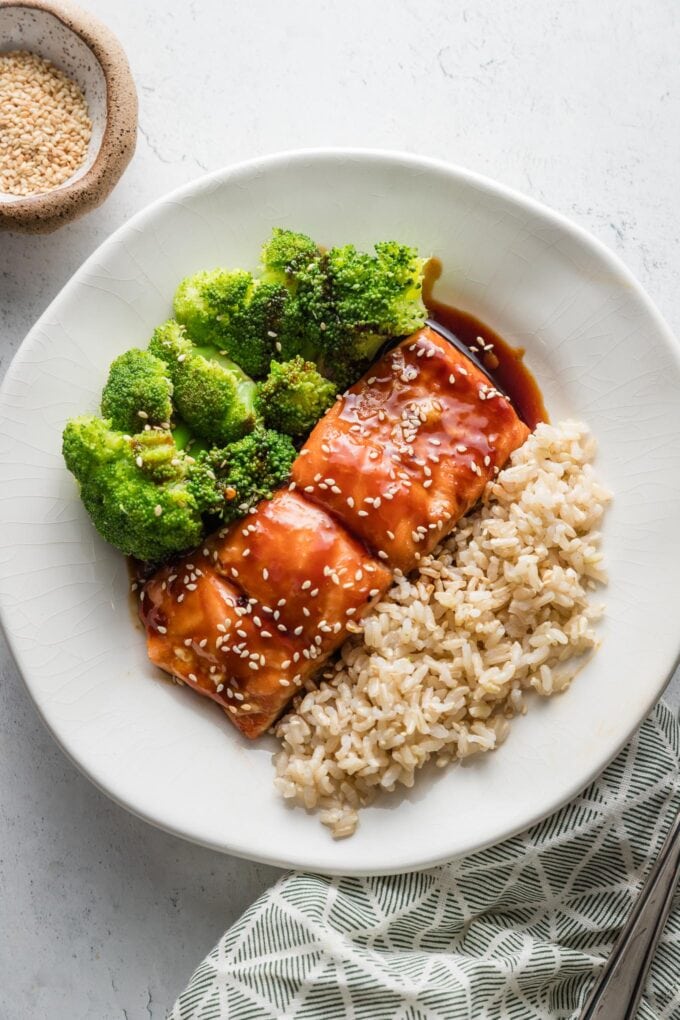
Frequently Asked Questions
Should you buy salmon with or without the skin?
If you have the option, I recommend buying salmon that still has the skin on. It will be a thick gray coating on one side of the pink, slightly translucent flesh. The skin helps keep the salmon in one piece and also helps to prevent overcooking. Be sure to bake the salmon with the skin side down on the roasting pan.
Salmon skin is also edible, so if you want to try it after cooking, go for it!
Can you start salmon in a cold oven?
Yes, and I actually love this method! Simply place the marinated salmon fillets on a lined baking sheet and transfer to a cold oven, then turn the oven onto 400 degrees F and set a timer for 20 minutes. This takes a little longer than beginning with a preheated oven, as one might expect, but often yields even more tender, flaky fish.
At what temperature is salmon cooked through?
The USDA officially recommends cooking salmon, along with all other fish and shellfish, to an internal temperature of at least 145 degrees F. Note, however, that salmon, like most all proteins, will continue to rise in temperature for several minutes after being removed from a heat source. Because of this, pulling out your salmon when the internal temperature reaches 125 to 135 degrees F — certainly by 140 — is a good route to safe yet tender filets. Use an inexpensive instant read thermometer to make taking this temperature easy and remove all the guesswork.
What does it mean to flake salmon with a fork?
If you don’t have an instant read thermometer, this is a great everyday way to test salmon for doneness. Using the side edge of a dinner fork, press gently on a filet about an inch from the edge. Fully cooked salmon will flake easily, meaning it separates along the embedded white lines, which are strips of fat.
If the salmon resists the gentle pressure of the fork, it is probably not yet quite done.
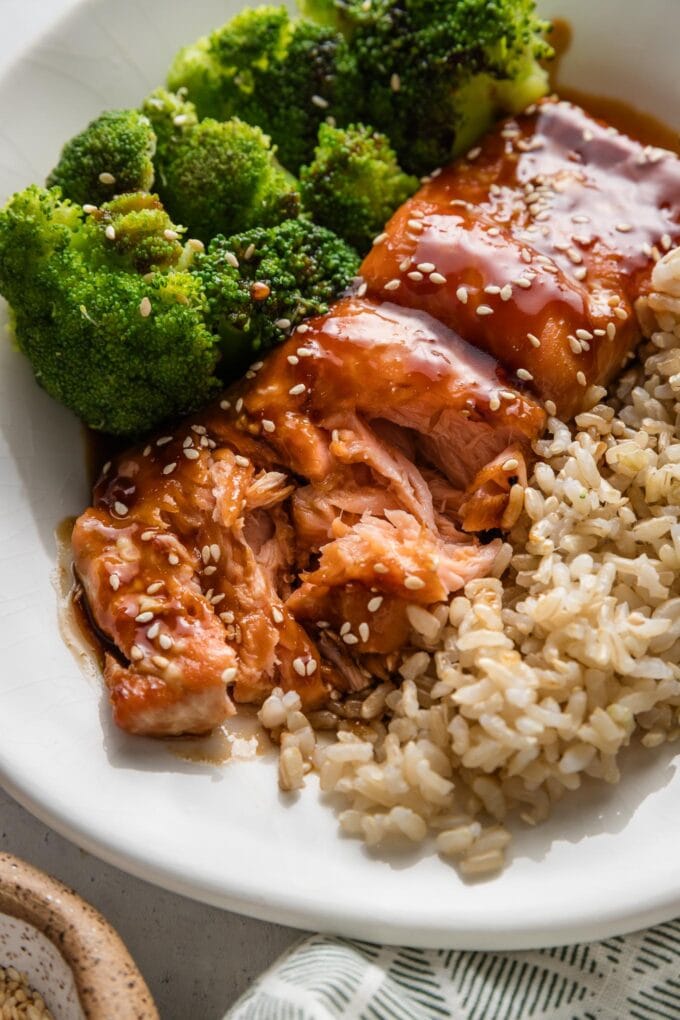
Serving Suggestions
Pair teriyaki salmon with any steamed or roasted vegetable. Our favorites include edamame, broccoli or broccolini, and asparagus, especially in the spring. It’s also nice with a simple cucumber salad for something light and crisp.
Brown rice, white rice, quinoa, or soba noodles are good choices to round out the plate. Whatever you do, feel empowered to drizzle extra teriyaki sauce over the side dishes. Yum!
Storage and Reheating
- To store: Keep any leftover salmon in the refrigerator for up to 4 days. It’s even delicious to eat cold straight out of the fridge, on its own or in a salad.
- To reheat: Warm in the microwave at 50% power. Using half-power warms salmon quickly but with less of the infamous “fish odor” and less chance of drying out.
More Salmon Recipes
- Easiest Honey Garlic Salmon
- Brown Sugar Glazed Salmon
- Pan-Seared Pistachio Herb Salmon
- Mustard-Crusted Panko Salmon
- Salmon Greek Salad
- Salmon Pesto Pasta
If you try this Teriyaki Salmon recipe, don’t forget to rate it and leave a comment below. I love hearing how recipes turn out in your kitchen, and it helps other readers, too.
You can also FOLLOW me on PINTEREST, INSTAGRAM, and FACEBOOK for more great recipes and ideas!
Teriyaki Salmon
Ingredients
- 1/2 cup low-sodium soy sauce
- 1/4 cup packed light brown sugar
- 2 Tablespoons rice vinegar
- 1 Tablespoon toasted sesame oil
- 1 Tablespoon honey
- 3/4 teaspoon ground ginger
- 1/2 teaspoon garlic powder
- 1/8 teaspoon red pepper flakes optional
- 1 teaspoon cornstarch plus 1 teaspoon cool water
- 4 salmon fillets 4-6 ounces each
- sesame seeds optional garnish
Instructions
- Combine soy sauce, brown sugar, rice vinegar, sesame oil, honey, ginger, garlic powder, and red pepper flakes if using in a small saucepan set over medium-high heat. Bring to a boil, then reduce heat to medium and let it bubble for 1-2 minutes.
- While the sauce is simmering, mix the cornstarch and cool water in a small bowl and stir into a thin slurry, then stir this into the soy sauce mixture. Keep bubbling until the sauce is thick enough to visibly coat the back of spoon. Set aside to cool for 5-10 minutes. (You can do this a few minutes or a few days ahead of time and store in the fridge.)
- Place salmon in a large bowl and pour about half of the sauce on top, reserving the rest. Set aside to marinate for 15-20 minutes at room temperature or up to 24 hours in the refrigerator.
- When ready to bake, heat oven to 400 degrees F and line a rimmed baking sheet with parchment paper for easy clean-up. Place salmon fillets skin side down on the sheet. Discard the sauce that was used as a marinade. Roast salmon for 12-15 minutes, until it flakes easily with a fork and reaches 135-140 degrees F in the thickest part.
- Serve salmon with rice or veggies as desired, with the reserved teriyaki sauce drizzled really generously on top and sprinkled with sesame seeds for a garnish. Enjoy!
Notes
- Rice vinegar: Apple cider vinegar or white wine vinegar — not to be confused with standard white vinegar — are good substitutes if needed.
- Brown sugar: I prefer light in this sauce but either light or dark works.
- Cornstarch slurry: Always incorporate cornstarch as a slurry — dissolved into cool water first — rather than adding the powder directly to a hot sauce. The slurry will thicken things up quickly but smoothly. In contrast, cornstarch powder mixed straight into a hot sauce will seize up into small clumps, which are very difficult if not impossible to whisk out.
- Cold oven variation: Pace the marinated salmon fillets on a lined baking sheet and transfer to a cold oven, then turn the oven onto 400 degrees F and set a timer for 20 minutes. This takes a little longer than beginning with a preheated oven, as one might expect, but often yields even more tender, flaky fish.
- Storage: Keep any leftover salmon in the refrigerator for up to 4 days.
- Reheating: Warm in the microwave at 50% power. Using half-power warms salmon quickly but with less of the infamous “fish odor” and less chance of drying out.
- Recipe: Adapted from Tastes Better from Scratch.




